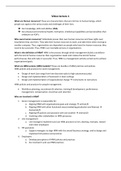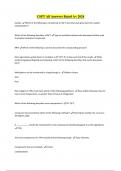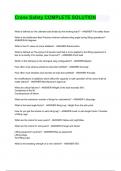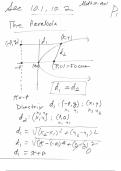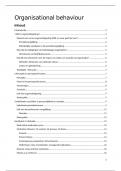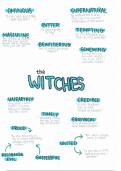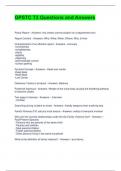Video lecture 1
What are Human resources? These are characteristics that are intrinsic to human beings, which
people can apply to the various tasks and challenges of their lives.
➔ Our knowledge, skills and abilities (KSA)
➔ Our physical and emotional health, motivation, intellectual capabilities and personalities that
underpin our KSA’s.
Who owns human resources? Individuals posses their own human resources and have rights over
how/where they use them. They take their human resources to work, and take them when moving to
another company. Thus, organizations are dependent on people who have the human resources they
need to be successful. Thus, HRM is an inevitable process in organizations.
What is the definition of HRM? HRM is the process through which management builds a workforce
with the kind of human resources their organization needs and creates the kind of human
performances that will make it successful. Thus, HRM is a management activity carried out to achieve
organizational goals.
What are HRM systems (HRM models)? These are bundles of HRM practices and policies.
HRM policies and practices for work management:
• Design of work (can range from low-discretion jobs to high autonomous jobs)
• Design and implementation of teamwork in team settings
• Design and implementation of organizational change → instruments to restructure
HRM policies and practices for people management:
• Workforce planning, recruitment & selection, training & development, performance
management, compensation, incentives and retention
Who are involved in HRM?
1. Senior management is responsible for:
a. Aligning HRM with organizational goals and strategy → vertical fit
b. Aligning HRM with other functional areas (marketing production and finance) →
horizontal fit
c. Aligning HR policies and practices with one another → internal fit
d. Involving other stakeholders in HRM processes
2. Line management
a. Line managers implement and use HRM practices to hire, develop, motivate, reward
and retain employees
3. HR specialists
a. Support managers to align HRM with the overall business strategy, and to design and
implement HR policies and practices
4. Employees
a. Develop perceptions of HRM policies and practices
b. Are involved in and use HRM practices
,What roles do HR specialists fulfill?
Strategic partner: he supports senior and line managers to develop HR strategy and to align the HR
policies and practices with the overall business strategy. He helps the senior and line managers to
align HRM with the other functional areas (such as financial areas).
Change agent: they build teams capacity in the organization. They participate in change management
teams, and try to gain trust from employees for change. They help employees by training and to
acquire new skills.
Administrative expert: develop and design HR practices. They deliver HR instruments and services.
They have knowledge of laws, personal data etc. they interview and operate with HR systems.
Employee champion: they focus on protecting the interests. They want to imply a positive work
culture, good atmosphere. They often use surveys to manage employees satisfaction and to support
shortcomings. They try to ensure that managers are fair towards all employees. They help the change
agent by offering training to employees.
What are the strategic goals of HRM? HRM is a management activity, executed by managers. There
are 2 sets of HRM goals: economic goals and socio-political goals.
Economic goals
1. Ensuring costs-effective labor: HRM is needs to secure the economic viability of the firm
(making a profit that investors and lenders (banks) consider acceptable). The business
generates a ROI that is acceptable. Thus, a fundamental economic goal of HRM is making
human resources productive at affordable costs.
, 2. Organizational flexibility: flexibility to quickly adapt changes towards certain market
circumstances. HRM can create flexibility in the form of:
i. short-run responsiveness:
* numerical flexibility (overtime, zero-time contracts)
* financial flexibility (mix of wages, performance-based bonuses)
* functional flexibility (cross-trained or multi-skilled employees)
ii. long-run agility
* capacity to create endurable changes to cope with radically changing environments
(offshoring production facilities → HRM model for dual workforce).
* long-run agility is difficult to achieve because established thoughts and routines in
organizations are hard to change.
3. Human resource advantage: firms that survive (that are economic viable) try to develop a
competitive advantage to enhance their profitability. Most competitive advantages are
temporary. Competitive advantages are most valuable when they are sustainable
(innovative systems are hard to copy: think of Apple, Tesla etc).
Competitive advantage: a company uses its resources in such a way that it performs at a
higher level than its rivals. This can be done in 2 ways:
1. Cost advantage: providing products and services at lower costs than its rivals
2. Differentiation advantage: providing better products/services than its rivals
HRM plays a pivotal role in developing competitive advantages through building human
capital advantage and social capital advantage.
Human capital advantage: firm attracts, hires, develops, motivates and retains more highly
talented employees than its rivals.
Social capital (or organizational process) advantage: firm develops superior ways of
combining the talents (KSAs) of individuals into collaborative activities leading to
competitive advantage and excellent organizational performance.
Firms use different HRM models for developing advantages. Some firms use elite models,
and some egalitarian models. In case of low-skill products and services, firms invest only
extensively in the human capital and social capital of their elite (management, marketing;
elite HRA) and employ the operating workforce in cost-effective ways.
In case of high-skill products or services, firms invest extensively in the human and social
capital of the entire workforce (egalitarian HRA) to ensure the delivery of high-quality,
highly priced products and services to their customers.
Socio-political goals
Firms are not only economic, but also social actors operating in societies: managers need to adapt
their HRM to legal requirements and social values and norms relating to how people should be
employed and treated at work. There are 3 pillars of institutional perspective (Scott, 2008):
1. Regulative: labor laws and legal rules
2. Normative: social values and norms (equality, opportunities, inclusion etc.)
3. Cultural-cognitive: how people think and behave in a society (natural culture)
1. Social legitimacy: employers differ in their social legitimacy goals. Some employers try to
avoid their legal responsibilities (underpayment of staff, breaches of health and safety at
work). Most employers however tend to adopt a baseline legitimacy goal to avoid
, prosecution and bad publicity. Some employers operate beyond the baseline by actively
promoting equal employment opportunities (EEO) and work-life and family-friendly
employment conditions. Mostly small firms.
2. Managerial power: managers use HRM to enhance their power as stakeholders, enabling
them to provide a firm with leadership, direction and coordination. Power-seeking behavior
can also become perverse (Williamson, 1964).
Agency theory (Jensen & Meckling, 1976): managers are active agents who can pursue their
short-term interest at the expense of the firm’s long-term interests:
o Exorbitant bonus payouts to banking executives (contributed to global financial
crisis)
o Trend to financialization: managing managers through short-term pay-for-
performance schemes.
o Ratio between CEO and average US worker pay
What is an organizational strategy? Organizational strategy is best understood and defined by
making a distinction between the strategic problems that firms encounter in their environment and
the strategies their managers adopt to address them. The most fundamental strategic problems are:
• Economic viability (establishing a viable business)
• Developing competitive advantage
For establishing a viable business the initial strategic problem for any management team is:
• Identifying a market opportunity and establishing a viable strategy (a viable way) of meeting
it.
• Establishing at least the minimum set of capabilities with which the firm can participate in a
particular industry: table stakes → the minimum entry requirement for a market or business
arrangement.
Strategic decisions and actions about table stakes are about 4 essential elements of any business:
marketing, production, HRM and funding.
What are Human resources? These are characteristics that are intrinsic to human beings, which
people can apply to the various tasks and challenges of their lives.
➔ Our knowledge, skills and abilities (KSA)
➔ Our physical and emotional health, motivation, intellectual capabilities and personalities that
underpin our KSA’s.
Who owns human resources? Individuals posses their own human resources and have rights over
how/where they use them. They take their human resources to work, and take them when moving to
another company. Thus, organizations are dependent on people who have the human resources they
need to be successful. Thus, HRM is an inevitable process in organizations.
What is the definition of HRM? HRM is the process through which management builds a workforce
with the kind of human resources their organization needs and creates the kind of human
performances that will make it successful. Thus, HRM is a management activity carried out to achieve
organizational goals.
What are HRM systems (HRM models)? These are bundles of HRM practices and policies.
HRM policies and practices for work management:
• Design of work (can range from low-discretion jobs to high autonomous jobs)
• Design and implementation of teamwork in team settings
• Design and implementation of organizational change → instruments to restructure
HRM policies and practices for people management:
• Workforce planning, recruitment & selection, training & development, performance
management, compensation, incentives and retention
Who are involved in HRM?
1. Senior management is responsible for:
a. Aligning HRM with organizational goals and strategy → vertical fit
b. Aligning HRM with other functional areas (marketing production and finance) →
horizontal fit
c. Aligning HR policies and practices with one another → internal fit
d. Involving other stakeholders in HRM processes
2. Line management
a. Line managers implement and use HRM practices to hire, develop, motivate, reward
and retain employees
3. HR specialists
a. Support managers to align HRM with the overall business strategy, and to design and
implement HR policies and practices
4. Employees
a. Develop perceptions of HRM policies and practices
b. Are involved in and use HRM practices
,What roles do HR specialists fulfill?
Strategic partner: he supports senior and line managers to develop HR strategy and to align the HR
policies and practices with the overall business strategy. He helps the senior and line managers to
align HRM with the other functional areas (such as financial areas).
Change agent: they build teams capacity in the organization. They participate in change management
teams, and try to gain trust from employees for change. They help employees by training and to
acquire new skills.
Administrative expert: develop and design HR practices. They deliver HR instruments and services.
They have knowledge of laws, personal data etc. they interview and operate with HR systems.
Employee champion: they focus on protecting the interests. They want to imply a positive work
culture, good atmosphere. They often use surveys to manage employees satisfaction and to support
shortcomings. They try to ensure that managers are fair towards all employees. They help the change
agent by offering training to employees.
What are the strategic goals of HRM? HRM is a management activity, executed by managers. There
are 2 sets of HRM goals: economic goals and socio-political goals.
Economic goals
1. Ensuring costs-effective labor: HRM is needs to secure the economic viability of the firm
(making a profit that investors and lenders (banks) consider acceptable). The business
generates a ROI that is acceptable. Thus, a fundamental economic goal of HRM is making
human resources productive at affordable costs.
, 2. Organizational flexibility: flexibility to quickly adapt changes towards certain market
circumstances. HRM can create flexibility in the form of:
i. short-run responsiveness:
* numerical flexibility (overtime, zero-time contracts)
* financial flexibility (mix of wages, performance-based bonuses)
* functional flexibility (cross-trained or multi-skilled employees)
ii. long-run agility
* capacity to create endurable changes to cope with radically changing environments
(offshoring production facilities → HRM model for dual workforce).
* long-run agility is difficult to achieve because established thoughts and routines in
organizations are hard to change.
3. Human resource advantage: firms that survive (that are economic viable) try to develop a
competitive advantage to enhance their profitability. Most competitive advantages are
temporary. Competitive advantages are most valuable when they are sustainable
(innovative systems are hard to copy: think of Apple, Tesla etc).
Competitive advantage: a company uses its resources in such a way that it performs at a
higher level than its rivals. This can be done in 2 ways:
1. Cost advantage: providing products and services at lower costs than its rivals
2. Differentiation advantage: providing better products/services than its rivals
HRM plays a pivotal role in developing competitive advantages through building human
capital advantage and social capital advantage.
Human capital advantage: firm attracts, hires, develops, motivates and retains more highly
talented employees than its rivals.
Social capital (or organizational process) advantage: firm develops superior ways of
combining the talents (KSAs) of individuals into collaborative activities leading to
competitive advantage and excellent organizational performance.
Firms use different HRM models for developing advantages. Some firms use elite models,
and some egalitarian models. In case of low-skill products and services, firms invest only
extensively in the human capital and social capital of their elite (management, marketing;
elite HRA) and employ the operating workforce in cost-effective ways.
In case of high-skill products or services, firms invest extensively in the human and social
capital of the entire workforce (egalitarian HRA) to ensure the delivery of high-quality,
highly priced products and services to their customers.
Socio-political goals
Firms are not only economic, but also social actors operating in societies: managers need to adapt
their HRM to legal requirements and social values and norms relating to how people should be
employed and treated at work. There are 3 pillars of institutional perspective (Scott, 2008):
1. Regulative: labor laws and legal rules
2. Normative: social values and norms (equality, opportunities, inclusion etc.)
3. Cultural-cognitive: how people think and behave in a society (natural culture)
1. Social legitimacy: employers differ in their social legitimacy goals. Some employers try to
avoid their legal responsibilities (underpayment of staff, breaches of health and safety at
work). Most employers however tend to adopt a baseline legitimacy goal to avoid
, prosecution and bad publicity. Some employers operate beyond the baseline by actively
promoting equal employment opportunities (EEO) and work-life and family-friendly
employment conditions. Mostly small firms.
2. Managerial power: managers use HRM to enhance their power as stakeholders, enabling
them to provide a firm with leadership, direction and coordination. Power-seeking behavior
can also become perverse (Williamson, 1964).
Agency theory (Jensen & Meckling, 1976): managers are active agents who can pursue their
short-term interest at the expense of the firm’s long-term interests:
o Exorbitant bonus payouts to banking executives (contributed to global financial
crisis)
o Trend to financialization: managing managers through short-term pay-for-
performance schemes.
o Ratio between CEO and average US worker pay
What is an organizational strategy? Organizational strategy is best understood and defined by
making a distinction between the strategic problems that firms encounter in their environment and
the strategies their managers adopt to address them. The most fundamental strategic problems are:
• Economic viability (establishing a viable business)
• Developing competitive advantage
For establishing a viable business the initial strategic problem for any management team is:
• Identifying a market opportunity and establishing a viable strategy (a viable way) of meeting
it.
• Establishing at least the minimum set of capabilities with which the firm can participate in a
particular industry: table stakes → the minimum entry requirement for a market or business
arrangement.
Strategic decisions and actions about table stakes are about 4 essential elements of any business:
marketing, production, HRM and funding.

